Mongolia
Modern Times
Golden rule of Traveling
"When Years have passed, after you're first visit to a country
Don't go Back; and keep the memories of the past"
But i did break my golden rule, and i got back after 16 years.
It was a calculated risk
Knowing the Western part of Mongolia is not a tourist-hub
and Ulaanbaatar is not the major key to my memories.
Well it proved to be a right choice: Of course Ulaanbaatar has changed in a traffic jam, and the monastries
are getting lost, as shoddily constructed buildings are thrown up all around,
but in the western part of the country
The times are passing slowly
Worldtraveler55
Ulaanbaatar
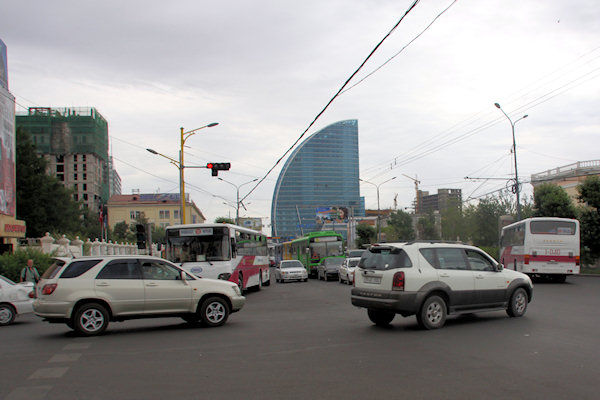 |
|||||
In 1911 when Mongolia first proclaimed its independence from China, the city became the capital of
Outer Mongolia and was named Niislei Khuree (Capital Camp). In 1918 it was invaded by the Chinese
and three years later by the Russians.
In 1924 the city was renamed Ulaanbaatar (Red Hero), in honour of the communist triumph, and declared the
official capital of an 'Independent' Mongolia. (independent from China, not from the Soviet Union). The
khangard (garuda), symbolising courage and honesty, was declared the city's official symbol.
From the 1930s, the Soviets built the city in typical Russian style; lots of ugly apartment blocks, large
brightly coloured theatres and cavernous government buildings. Tragically, the Soviets also destroyed many
old russian buildings as well as Mongolian monastries and temples.
Today the city booms with new private construction projects although a comprehensive infrastructure plan
has been slow to implement. It has also enjoyed cultural resurgence with lots of museums, galleries,
theatre performance and clubs bringing out the best in traditional Mongolian culture.
Sükbaatar Square
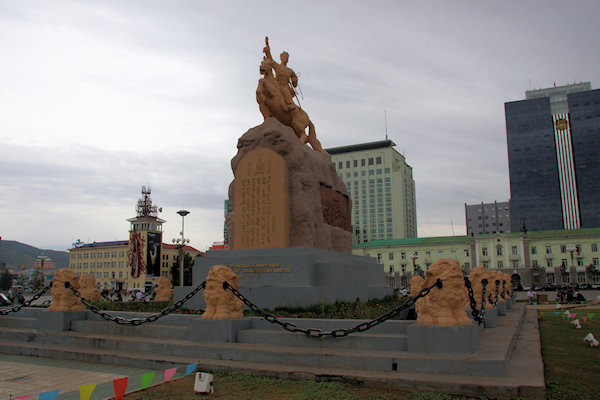 |
|||||
In july 1921 in the centre of Ulaanbaatar, the 'hero of revolution',
Dandin Sükbaatar, declared Mongolia's final independence from the Chinese. The square now bears his
name and features a statue of him astride his horse. The words he
apparently proclaimed at the time are engraved on the bottom of the statue:
If we, the whole people, unite in our common effort end common will, there will be nothing in the world
that we cannot archive, that we will not have learn or failed to do
The enormous marble construction on the north end was completed in 2006 in time for the 800-year anniverary
of Chinggis Kaan's coronation. At its centre is a seated bronze Chingis Khaan statue lording over
his nation. He is flanked by Ogedei (on the west) and Kublai (east) Two flamed Mongol soldiers
(Boruchu and Mukhlai) guard the entrance to the monument.
The clay-red building to the southwest is the Mongolian Stock Exhange, which was opened in 1992 in
the former Children's chinema.
Gandan Khiid
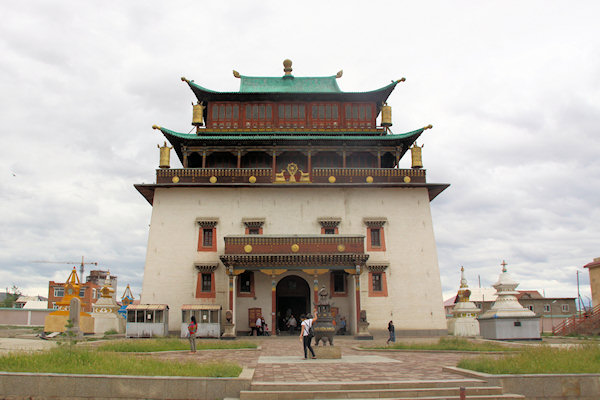 |
|||||
This monastry is one of Mongolia's most important and also one of its biggest tourist attractions.
The full name Gandantegchinlen, translated roughly as "the great place of complete joy".
Today, more than 600 monks belong to the monastery.
At the end of the main path as you enter is the magnificent white Migiid Janraisig Süm, the
monastry's main attraction.
Linning the walls of the temple are hundreds of images of Arush, the Buddha of longevity, which
stare through the gloom to the Migiid Janraising statue.
The original statue was commissioned by the eight Boghd Khan in 1911, in hopes that it might restore
his eyesight - syphilis had blinded him; however it was carted away by Russia in 1937.
The New statue was dedicated in 1996 and built with donations from Japan and Nepal.It is 26 m high and made
of copper with a gilt gold covering. The hollow statue contains 27 tonnes of medicinal herbs, 334 sutras,
two million bundles of mantras, plus an entire ger with furniture!
to the east of the temple are four colleges of Buddhist philosophy, including the yellow building dedicated
to Kalachakra, a wrathful Buddhist deity.
Halfway the main path, a path leadstowards the right to a courtyard containing two temples.
The north-east building is Ochidara Temple (sometimes called Gandan Süm) where the most significant
ceremonies are held. The large statue behind glass is Tsongkhapa, the founder of the Gelugpa sect.
The two-storey Didan-Lavran Temple in the courtyard was home to the 13th Dalai Lama during his stay
here in 1904.
Winter Palace of Bogd Khan
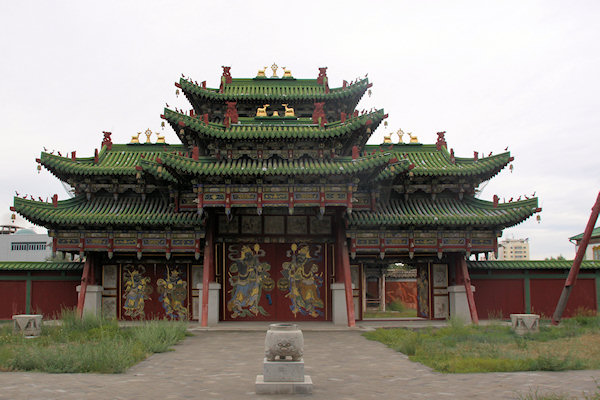 |
|||||
Built between 1893 and 1903, this palace is the place where Mongolia's eight Living Buddha, and last
king, Jebtzun Damba Hutagt VIII (often called the Bogd Khan, lived for 20 years.
There are six temples in the grounds.
The White building to the right as you enter is the Winter Palace itself. It contains a collection
of gifts received from foreign dignitaries, such as a pair of golden boots from a Russian Tsar, a robe made
of 80 unfortunate foxes and a ger lined with the skins of 150 snow leopards.
The Library contains some of the remaining Sutras, printing blocks and clay icons.
In the centre of The Temple of many Deities the 4th Panchan Lama Chogloinamjil's portrait is
on display.
Choijn Lama Temple Museum
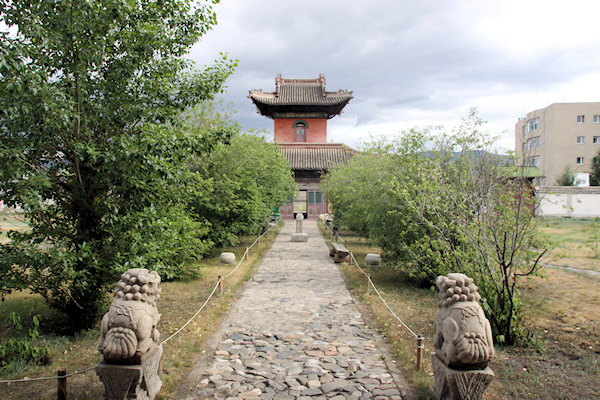 |
|||||
This Temple Museum is a hidden gem of architecture and history, smack in the middle of downtown
Ulaanbaatar. It was home of Luvsan Haidav Choijn Lama, the state oracle and brother of the
Bogd Khan.
The construction of the monastry commenced in 1904 and was completed four years later. It was closed in
1938 and probably would have been demolished but it was saved as a museum in 1942 to demonstrate the
'feudal' way of the past. Although religious freedom in Mongolia recommenced in 1990, this manastry
is no longer an active place of worship.
There are five temples featuring statues of Sakyamuni (the historical Buddha), Choijn Lama
and Baltung Choimba, the teacher of the Bogd Khan.
Free cultural performance are held here in summer; this is a great change to see tsam-mask dancing
and to listen to khöömii, (throat singing).
Mongolian National Song & Dance Ensemble
Mongolia, being a nomadic nation has developed a strong tradition of vocal music. The closeness to
nature and the animal husbandry that the Mongolians have embraced for hundreds of years has enabled a
variety of amazing vocal styles to develop.
A performance of traditional music and dance is held every evening in the National Academic Drama
Theatre.
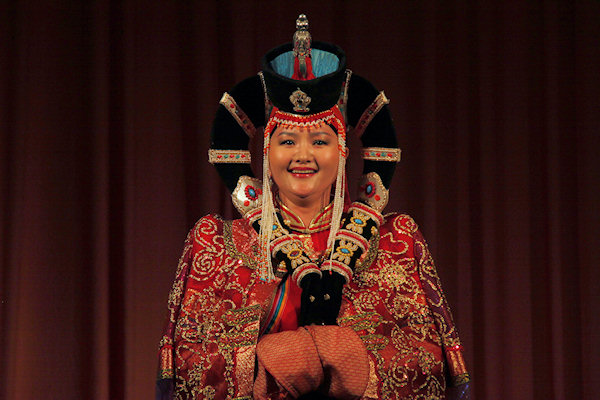 |
|||||
Urtyn Duu (Long Song)
For the Mongolians, the long song evokes the vast drawn out steppes. Its nostalgic tendencies generate a
preference for slow tempos, long melodic limes, wide pitch intervals and the absence of measured rhytm.
Long songs are sung by woman and men and are usually accompanied by the Morin Khuur (Horse Head
Fiddle) or sometimes the Limbe (Transverse Flute).
Khoomii (Overtone Singing)
Khoomii is a magical style of singing found in the central Asian Altai-mountains. It's particulary strong
in Western Mongolia, Tuva-region and the Gorno Altai-region (both part of the Russian Federation). Khoomii
is a technique which allows one person to sing two or even three distinct pitches at the same time. The
singer utilizes the harmonic or overtone series to do this.
Morin Khuur (Horse Headed Fiddle)
Without doubt the most quintessential of Mongolian instuments is the Morin Khuur. The Morin Khuur is a two
stringed spiked fiddle. The strings are made from the tail of a horse and run from the end of the spike at
the base, over the wooden bridge on the body, over the nut and through the neck to the turning pegs or
ears.
Contortionism
Contortionism has been a tradition in Mongolia for hundreds of years, and is a common act in Mongolian and
Chinese circuses. It was first performed as part of the traditional Buddhist Tsam dances and has
been incorporated into many Mongolian plays. It has come to be considered as an art rather than an
acrobatic act, and famous contortionists become national celebrities.
Tsam Dance
The ancient religious mask dance, or Tsam, is a significant religious ritual which reflects Buddhist
teachings through images. It is a theatrical art performed by skilled dancers wearing magnificently
ornamented costumes, which represent characters of different holy figures and devils, animals, and
people.
The Old White Man
The Mongolians worship the Old Man. He is a God of Fertility and the symbol of a long life. He is
also considered the protector of the herds and the giver of the harvest. In the Tsam he plays the role of
a clown, and he distributes sweets.
Naadam Festival
The Naadam Festival is locally termed Eryn Gurvan Naadam (The tree Games of Men), which are
wrestling, horse racing and archery. Every village and city has a naadam; most (including the one in
Ulaanbaatar) are held on 11 and 12 july, coinciding with Independence day. Some rural naadams are held a
few days before or after this date, so some planning is required if you want to seen one.
For travellers, rural naadams provide the opportunity to see genuine traditions and events not tarted up
for the sake of tourism. You'll get closer to the action and may even be asked to make up the numbers
during the wrestling tournament.
I did visited the naadam festival at Sagsai, a small town 25 km east of Ölgii.
Wrestling
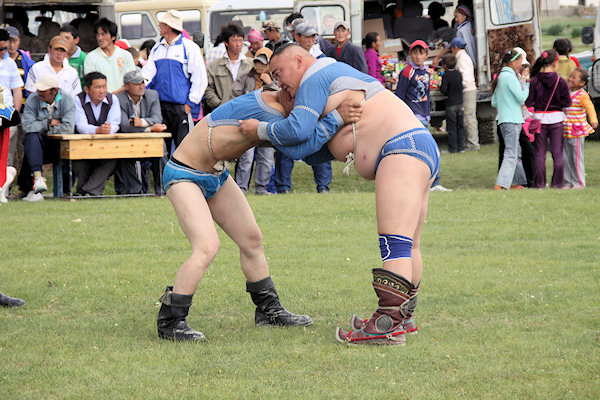 |
|||||
The wrestling competition begins around noon on the first day of the festival and end on the second
day.
Mongolian wrestling is similar to wrestling found elsewhere, but they have tow important differences.
First, there are no weight divisions. A small wrestler can be pitted against someone two times his weight.
This can lead to some very interesting matches.
A top 4 ranked wrestler become the title of Zaan (elephant) and everyone who is ranked in the top
16 becomes a Nachin (falcon).
Horse Racing
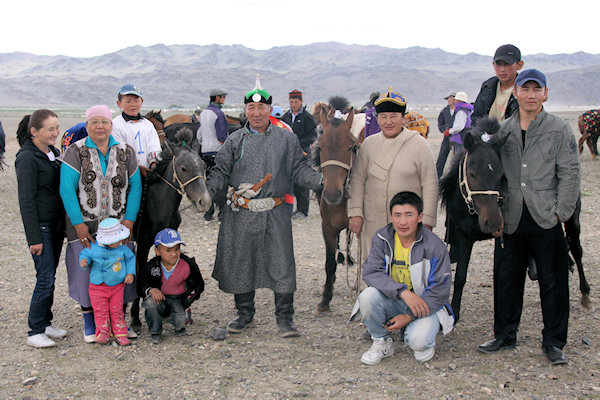 |
|||||
Mongolia's second-biggest sport is horse racing. Jockeys - traditionally children between the ages of
five and 12 years - race over open countryside
There are six catagories, based on the age of the horses. the tree-year-old horses, called Shudlen
race for about 16 km and the six-year-old, called Ikh Nas race for 30 km.
winning horses are called Tümnii Ekh (leader of 10.000). riders and spectators rush to comb the
sweat off the best horses with a scraper traditionally made from a pelican's beak. The five winning
riders must drink some special airag (fermented mare milk), which is then often sprinkled on the
riders'heads and the horses'backsides.
Archery
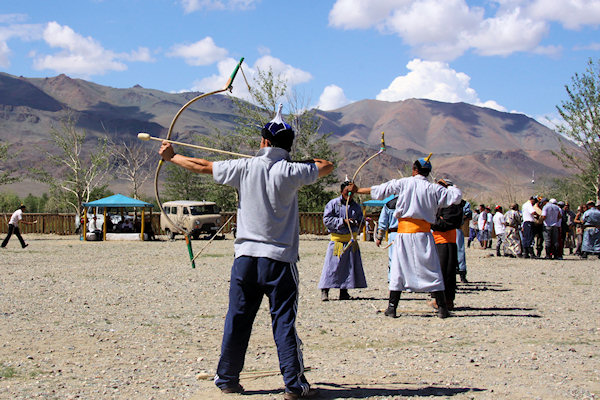 |
|||||
The sport of archery originated around the 11th century.
After each shot, judges who stand near the target emit a short cry called Uuklai and raise their
hands in the air to indicate the quality of the shot.
The winning archer is the one who hits the tragets the most times.
Ölgii
Bayan-Ölgii Aimag
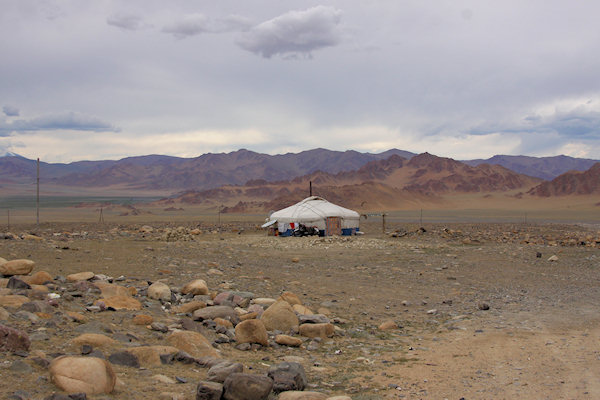 |
|||||
Travelling to Mongolia's western most aimag (province) gives one the distinct feeling of
reaching the end of the road, if not the end of earth.
High, dry, rugged and raw, the isolate, oddly shaped province follows the arc of the Altai Mountains.
Many peaks in the province are more than 4.000m and permanently covered with glaciers and snow, while
the valleys have a few green pastures that support about two million livestock, as well as bear, fox and
wolf.
About 90% of the population in this province are Kazakh.
Eagle-hunting is a Kazakh tradition dating back about 2.000 years. Female eagles are almost always used,
as they are one-third heavier than the males and far more aggresive.
During my visit in Ölgii, the aimag combined it's 70-year anniversary celebration and Naadam
with two days of parades, costumes, concerts, horse-racing, wrestling, archery and all-around
merry-making.
It was definitely a holiday for the locals.
I was happy to join in the periphery.
Ölgii
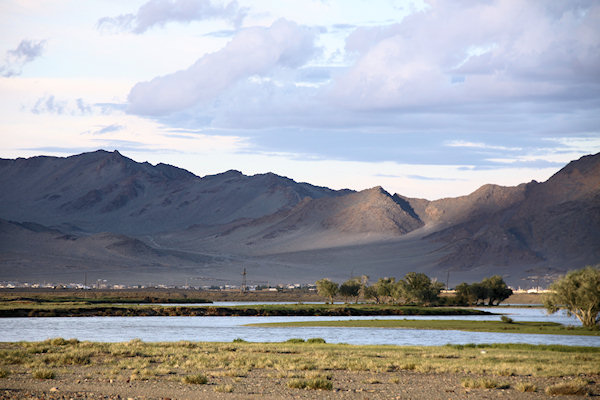 |
|||||
Ölgii city is a windblown frontier town that will appeal to anyone who dreams of the Wild West.
It's a squat, concrete affair, meandering along the Khovd Gol and surrounded by ger districts and
rocky escarpments. Thunderclouds brew in the mountains above town, making for some dramatic climatic
changes throughout the day and brilliant light shows in the late afternoon.
The town is predominantly Kazakh, and you'll soon start feeling it has more in common with Muslim-influenced
Central Asia than Buddhist Mongolia; there are signs in Arabic and Kazakh Cyrillic, and the market, which
is called bazaar, sells the odd shashlik (kebab) and is stocked with goods from Kazakhstan.
A friendly local population makes the place a welcome break on a long journey and the logical place to
launch an expedition into the Altai mountains.
Border crossing Russia
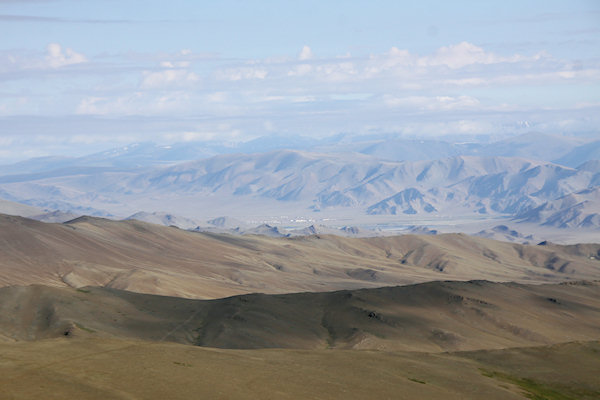 |
|||||
There is no public transport across the Tsagaannuur-Tashanta border; however trade across the
border is brisk, so if you ask around the market in Öglii you should be able to negotiate a ride all the
way to the Russian town of Kosh-Agach.
There isn't much point in getting a ride just to Tsagaannuur as most cars drive right past on their way
to the border, and the no-man's land is several kilometers wide.
On you're way you get some dramatic scenery, so keep the cammera in state of use.
Unfortunatly, due to the anniversary-thing in Öglii, the border was closed for some day's; so whe have
to wait; telling story's to the Russian/Polish-travellers and drinking some vodka/beer with them (they
were also stuck at the border) and watching some very nice sunsets.